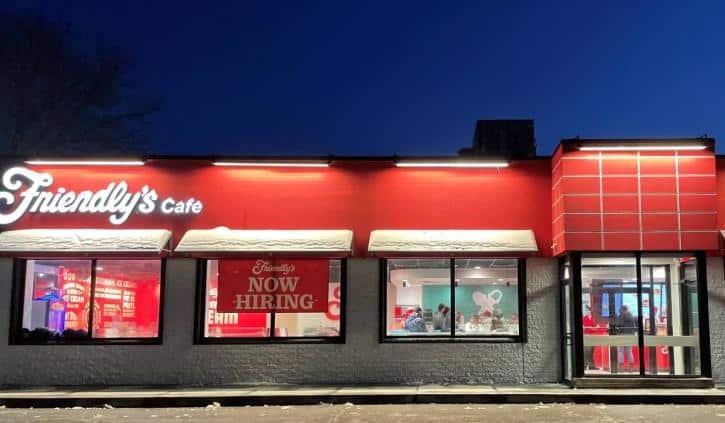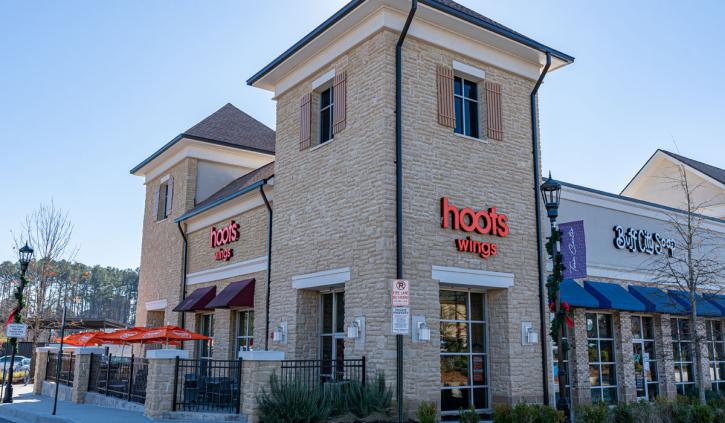






Flipping the switch
Full-service restaurants are getting their “quick service” on like never before.
Though not necessarily a new story in the ever-evolving restaurant industry—to be certain, full-service heavyweights like Chicago-based Lettuce Entertain You Enterprises and acclaimed chefs such as Rick Bayless have marched into the limited-service world before—sit-down restaurants migrating into the quick-service environment is becoming a more commonplace tale these days.
While a competitive industry has long forced restaurants of all stripes to be creative, the pandemic demanded it, especially as COVID-19 shuttered dining rooms and paralyzed many full-service operations.
Note: If viewing on a desktop, click the arrows in the photo to see the next slide.
The landscape shifts
Though table-service brands like Buffalo Wild Wings and IHOP had quick-service-oriented formats in motion before the pandemic overturned daily life, COVID threw accelerant on those plans while intensifying the conversations many other full-service restaurant leaders were having about diving into counter-service waters.
With off-premises occasions like carryout, delivery, and drive-thru orders swelling amid the pandemic, full-service operations saw more promise than ever in the quick-service category, not to mention a shot at survival by taking their brand equity downstream. But even as pandemic restrictions eased, full-service dining rooms reopened, and consumers expressed a greater willingness to dine out, the appeal of the more straightforward, less labor-intensive quick-service model remains strong for full-service brands.
Nearly two years after announcing plans for a fast-casual concept, Flip’d by IHOP debuted in Lawrence, Kansas, last September. Over recent months, additional Flip’d restaurants have opened in New York City, Cincinnati, and Silver Spring, Maryland. Meanwhile, Buffalo Wild Wings, which opened its first Buffalo Wild Wings GO unit in May 2020 outside Atlanta, is touting plans for 100 GO restaurants by the close of 2022, while Steak ‘n Shake is converting its 500-plus restaurants into quick-service formats, leaning heavily into digital ordering, self-service kiosks, and drive-thru operations to do so.
But it’s not just the mighty national full-service chains pushing their way into the quick-service ranks. Independent restaurateurs and restaurant groups are also making the trek.
In December 2020, the Duggan family, which had been serving old-school Italian-American fare at Original Joe’s in California’s Bay Area for more than eight decades, launched Little Original Joe’s in San Francisco’s West Portal neighborhood. The quick-service-styled eatery pairs pizza, pasta, and parmigiana dishes with a marketplace featuring ready-to-cook favorites from Original Joe’s.
And earlier this year, the husband-and-wife team of Joe and Katy Kindred, who found full-service success near Charlotte with Kindred and Hello, Sailor, opened a donut-peddling, chicken-slinging fast casual called milkbread in Davidson, North Carolina.
QSR talked with five full-service restaurant companies about their moves into the quick-service world:
Hooters to Hoots Wings
Debut: February 2017 in Cicero, Illinois
Motivating Factors:
Hooters leadership noticed a healthy rise in off-premises orders as early as 2010, including some Hooters restaurants collecting as much as 20 percent of their sales from carryout. “We saw the appetite for this and went after it,” says Sal Melilli, CEO of HOA Brands, Hooters’ parent company. “We like to be user-friendly to help our guests and creating Hoots leaned into their demands.”
Compare and Contrast:
Hoots units cover 1,300–1,800 square feet, a far cry from the 5,000–7,000-square-foot spaces of the typical Hooters restaurant. Hoots restaurants also drop the TV packages, world-famous Hooters girls, and full alcohol service found in traditional establishments. Hoots does, however, embrace the top-selling menu items of its full-service sibling, namely wings, shrimp, a chicken sandwich, and tenders. Menu boards feature bundles and catering packages as well.
Early Returns:
Before the pandemic, Melilli saw consistent positive returns at Hoots across several states, which offered proof of concept. The pandemic, though, was the real validator. As consumers hungered for value, convenience, and variety, Hoots delivered with naked, breaded, roasted, smoked, and boneless wings as well as 15 different sauces and rubs. “With what we experienced with demand and interest, it’s clear this model fits the bill,” Melilli says.
What’s Next:
Hoots will end 2022 with 15–18 stores in operation and Melilli touts nearly 100 more in the development pipeline. He also cites ghost kitchen and international possibilities as well. “We’ve got runway here to build out and bring more online,” Melilli says.
P.F. Chang’s China Bistro to P.F. Chang’s To Go
Debut: February 2020 in Chicago
Motivating Factors:
Seeing rising appetite for carryout at its bistro locations, P.F. Chang’s leadership began working on a to-go concept in 2018. A quick-service concept, leaders reasoned, would position P.F. Chang’s to build a presence in areas in which it lacked current activity while enabling it to add to markets with already thriving bistro locations. “We theorized that people wanted P.F. Chang’s more often, so we tried to figure out how to get it to them,” says Candice Barnett, vice president of off-premises dining at P.F. Chang’s.
Compare and Contrast:
While eliminating the most complex items, To Go locations embrace the same recipes and scratch-made cooking methods as bistro locations, including dishes like Chang’s Spicy Shrimp and Kung Pao Chicken. In all, the To Go menu represents about half of the bistro menu. “Our food is our food and we maintain integrity there,” Barnett says. Most space at the 2,000–2,500-square foot To Go locations is devoted to the kitchen, and while the first P.F. Chang’s To Go restaurant in Chicago offered no seating, all new locations now include limited indoor dining. The company is also retrofitting its current To Go fleet to include seating as well.
Early Returns:
Barnett says P.F. Chang’s To Go performance is “getting better all the time.” She reports favorable returns in suburban markets as well as an uptick in urban markets, where the office reopenings have spurred lunch and catering orders.
What’s Next:
Barnett says P.F. Chang’s will near 30 To Go eateries by year’s end. “These restaurants are not making as much money as the bistro locations, but we’re able to build a lot more of them because of the pricing structure and markets we can get into,” Barnett says.
Bennigan’s to Bennigan’s On The Fly
Debut: January 2021 in Coralville, Iowa
Motivating Factors:
For Paul Mangiamele, chairman and CEO of Legendary Restaurant Brands, Bennigan’s parent company, launching the Bennigan’s On The Fly concept is about offering more diverse franchising opportunities, leveraging the treasured Bennigan’s brand, and corralling a new demographic. “This game is all about market share capture,” Mangiamele says. “When you open the funnel and bring your brand to more people and in different categories, you create new opportunities to gain customers for franchisees and the brand.”
Compare and Contrast:
From the Turkey O’Toole to Oh, Baby Back Ribs, On The Fly customers can order many of the same core—and trademarked—menu items available at a traditional Bennigan’s. While the typical full-service Bennigan’s sits in a free-standing, 5,200-square-foot restaurant with a full bar and patio, Mangiamele says the company’s quick serve is a “completely adaptable concept,” whether that means drive-thru service, nontraditional venues like airports and arenas, or bar seating with beer and wine. “We will collaborate with our franchisees to make the unit economics work,” he says.
Early Returns:
“Very pleased,” Mangiamele says, adding that positive initial results weren’t surprising given the strong connections many have to the Bennigan’s brand. “My belief is that nostalgia never goes out of style.”
What’s Next:
More than a dozen Bennigan’s On The Fly restaurants are in the current development pipeline, and Mangiamele sees significant potential for growth. He notes opportunities with ghost kitchens, second-generation restaurant spaces, and internationally in locales such as Iraq, Turkey, and Central America. “There’s a lot of upside opportunity for us now and we’re all about taking advantage of it,” Mangiamele says.
Famous Dave’s to Famous Dave’s Quick ‘Que
Debut: August 2021 in Las Vegas
Motivating Factors:
With barbecue ready to be served on demand after hours of preparation, Famous Dave’s can execute fast ticket times to provide guests the food and convenience they crave. “The evolution of convenience makes it a necessity,” Famous Dave’s CEO Jeff Crivello says. The smaller footprints, compelling real estate opportunities, and simplified operations of the quick-service environment certainly appealed to company leadership as well.
Compare and Contrast:
While the Quick ‘Que menu resembles that of Famous Dave’s full-service restaurants, the company eliminated steps of service to ensure a faster, more convenient experience. “People want less human contact, at a faster pace, and on demand,” Crivello says.
Early Returns:
Quick ‘Que has captured quick success, Crivello says, as customers appreciate the ability to get Famous Dave’s hearty barbeque via delivery, dine-in, carryout, or the drive-thru, where Famous Dave’s boasts ticket times on par with other quick-service concepts. “We know the demand is there,” Crivello says.
What’s Next:
Crivello calls the Quick ‘Que model Famous Dave’s primary growth vehicle moving forward. Soon after opening in Las Vegas last August, additional Quick ‘Que locations opened in Coon Rapids, Minnesota, and South Salt Lake, Utah, a nod to Famous Dave’s national plans for the nascent concept. And while traditional full-service restaurant development will continue, albeit with restaurants carrying a reduced footprint, Crivello says Famous Dave’s has current and prospective franchise partners eager to build a Quick ‘Que.
Friendly’s to Friendly’s Café
Debut: February 2022 in Westfield, Massachusetts
Motivating Factors:
Friendly’s CEO and president Craig Erlich says current times call for a model like Friendly’s Cafe to complement the company’s traditional full-service restaurants. The café concept enables Friendly’s to serve guests in a new way while empowering the company to explore innovations in menu and technology. “[Quick-service] and fast-casual concepts are leading the way during a time when customers prioritize convenience and flexibility in their dining experience without having to compromise quality, service, or tradition,” Erlich says.
Compare and Contrast:
Whereas the traditional Friendly’s restaurant averages about 3,800-square feet, the Westfield café covers but 2,700 square feet, a more compact size that positions Friendly’s Café to enter different markets. The new restaurant’s menu pairs beloved Friendly’s classics like SuperMelts and ice cream sundaes with new options like Tater Kegs, the $100,000 Cobb Salad, and a Dorito’s Cool Ranch ChoppedCheese Burger. Guests order at the counter or via a QR code at the table before staff delivers food to the table. “This new concept is very exciting because it shows how we are growing and enhancing the Friendly’s brand, while also maintaining key staples that make the brand what it is,” Erlich says.
Early Returns:
In advance of its early 2022 opening, Erlich heard mixed opinions about how the café concept would be received. Within the café’s first week, however, he says the company had received “a lot of positive feedback from customers.”
What’s Next:
Friendly’s leadership intends to open additional Friendly’s Café restaurants, but it will first monitor results of the Westfield location. “As with any new concept, we want to gain feedback on what is working and what’s not and fine-tune along the way,” Erlich says.





